Tribunal Statistics Quarterly, October to December 2020
Published 11 March 2021
1. Main Points
This publication gives tribunal statistics for the latest quarter (October to December 2020, Q3 2020/21), compared to the same quarter the previous year. This quarter’s Tribunal Statistics publication does not include Social Security and Child Support (SSCS) receipts (table SSCS_1) and total disposals (table SSCS_2) due to ongoing issues identified during migration to a new operations system. Quality assurance checks performed on this data could not match cases migrated from the old system, GAPS2 to the new system - Core Case Database, CCD. This led to cases being double counted which in turn affected timeliness and performance figures. Disposals cleared at hearing and their outcome by benefit type is included (table SSCS_3) as this data was unaffected by the migration. The complete back series will be made available next quarter once checks are complete and the data quality assured. This bulletin will focus on all the other individual tribunals and not the overall picture as the excluded tribunal forms a large proportion of the overall caseload.
For technical detail about data sources, quality, policy changes and terminology, please refer to the accompanying Guide to Tribunal Statistics.
| FTTIAC receipts and disposals decreased while caseload outstanding increased | First-Tier Tribunal Immigration and Asylum Chamber (FTTIAC) receipts and disposals fell (by 31% and 49% respectively) compared to the same period in 2019. Caseload outstanding rose, by 20%, over the same period. |
| Single ET claims received continued to rise Multiple ET claims increased |
Single Employment Tribunal (ET) receipts and caseload outstanding increased, by 25% and 36% respectively, compared to a year ago. Disposals remained stable. Multiple ET receipts, disposals and caseload outstanding all increased by 82%, 66% and 12% respectively, over the same period. |
| SEND receipts, disposals and caseload outstanding all increased | SEND receipts, disposals and caseload outstanding rose compared to the same period in 2019, by 6%, 10% and 18% respectively. |
| Mental Health tribunal receipts and disposals fell while caseload outstanding remained stable | Mental Health receipts and disposals both decreased slightly compared to the same quarter a year ago (by 4% and 3% respectively). Caseload outstanding remained stable over the same period. |
| FTTIAC and ET timeliness increased | All timeliness figures for FTTIAC and ET increased compared to a year ago due to the affect the pandemic restrictions had on the tribunals. |
For feedback related to the content of this publication, please contact us at CAJS@justice.gov.uk
2. Statistician’s Comment
This quarter, there has been a fall in Tribunal receipts for most jurisdictions apart from Employment Tribunals, where demand rose to above pre-C19 levels in both Single and Multiple receipts; most likely due to the rise in unemployment and changes to working conditions seen during the COVID-19 pandemic. The return of face to face hearings, as well as the substantive use of remote hearings in courts, has increased ET disposals back to pre-C19 levels. We expect to see a slowdown in receipts with the announcement to continue the furlough scheme till Autumn 2021.
Government C-19 measures put in place for Immigration and Asylum led to a significant drop in both receipts and disposals in the FTTIAC. However, this quarter, we have begun to see growth in receipts for Immigration and Asylum cases as the guidance has ended and decisions on visa applications have restarted. Disposal volumes have doubled compared to the start of the pandemic, although it remains below the levels seen pre-C-19.
Again, due to C-19, the government has put temporary legislation and directions in place for Mental Health and Special Educational Needs and Disability (SEND) appeals. While there have been no big changes in receipts this quarter, we will continue to monitor the effect these changes have on volumes in the medium to long term.
Time taken to clear cases has increased as restrictions put in place due to C-19 have meant lower sittings volumes and reduced disposal rates. To support access to justice, audio and video technology capability has been increased, enabling judges to conduct remote hearings to a far greater degree.
Additional time is still required to resolve the SSCS receipts and disposal data quality issues identified during migration between two operational systems. The complete back series will be published next quarter once checks are complete and the data quality assured.
3. Immigration and Asylum
First-tier Tribunal Immigration and Asylum Chamber (FTTIAC)
In October to December 2020, FTTIAC receipts and disposals decreased, by 31% and 49% (to 7,700 and 6,100) respectively, compared to the same period in 2019.
In the same period, caseload outstanding increased by 20% (to 24,000).
Figure 3.1: First-tier Tribunal Immigration and Asylum Chamber receipts, Q3 2018/19 to Q3 2020/21 (Source: Tables FIA_1)
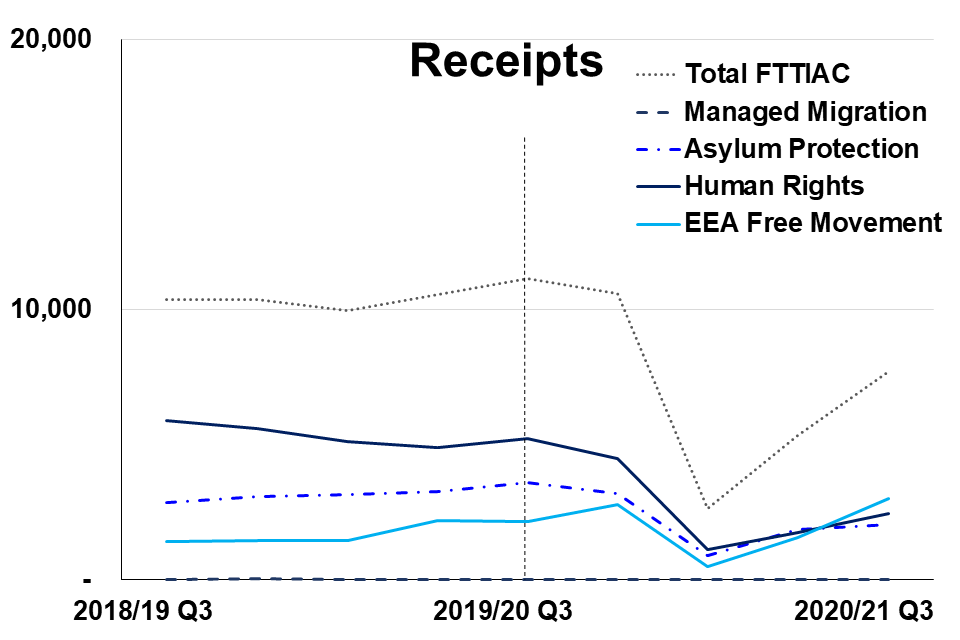
Figure 3.2: First-tier Tribunal Immigration and Asylum Chamber disposals, Q3 2018/19 to Q3 2020/21 (Source: Tables FIA_2)
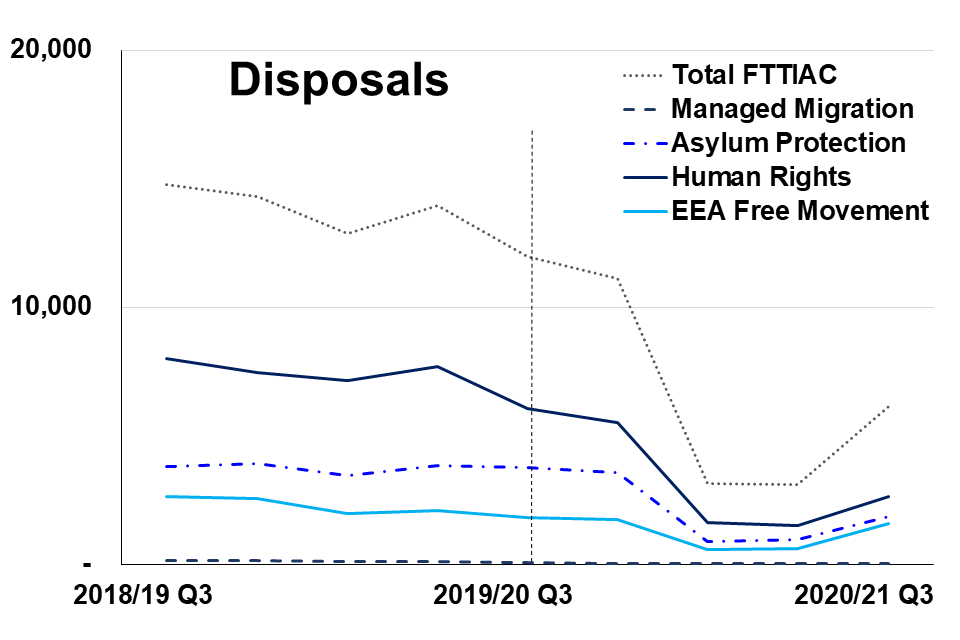
Figure 3.3: First-tier Tribunal Immigration and Asylum Chamber caseload outstanding, Q3 2018/19 to Q3 2020/21 (Source: Tables S_4)

In October to December 2020, EEA Free Movement receipts proportionally represented 39% of all FTTIAC receipts (up from 19% a year ago). In Q3 2020/21 there was a 53% and 43% decrease in Human Rights (HR) and Asylum/Protection (AP) receipts respectively (to 2,400 and 2,100 respectively), compared to the same period in 2019. EEA Free Movement receipts increased by 40% (to 3,000) over the same period. HR and AP proportionally represented 32% and 27% of all FTTIAC receipts respectively (down 15 and 6 percentage points respectively from a year ago).
Lower volumes seen in FTTIAC are likely due to measures put in place by the Home Office in response to coronavirus. These include: extending visas until 31st July 2020 due to travel restrictions or self-isolation related to coronavirus; switching to long-term visas; extending visas for NHS workers; relaxing conditions for Tier 1 entrepreneur visas and sponsors duties; cancellation of face-to-face substantive asylum interviews and allowing further submissions for a new claim by post or email; and allowing asylum seekers and refugees to remain in government accommodation until end of June 2020. Now that the Home Office has ended these measures and EU exit negotiations have concluded, demand is increasing, with receipts rising quarter on quarter since Q2 2020/21, but still lower than pre-pandemic levels.
The FTTIAC disposed of 6,100 appeals in October to December 2020, an 49% decrease on the same period in 2019. This fall was driven by an 51%, 57% and 14% fall in AP, HR and EEA respectively. Human Rights appeals continue to make up the largest proportion (43%) of all FTTIAC disposals in October to December 2020, down from 51% a year ago.
Of the disposals made in the FTTIAC this quarter, 57% were determined i.e. a decision was made by a judge at a hearing or on the papers; 27% were withdrawn; 4% were struck out for non-payment of the appeal fee, and 3% were invalid or out of time. Just under half (46%) of the 3,500 cases determined at a hearing or on the papers were allowed/granted, although this varied by case type (46% of Asylum/Protection, 50% of Human Rights and 39% of EEA Free Movement appeals were allowed/granted).
In the FTTIAC, the mean time taken to clear appeals across all categories has increased by 14 weeks to 44 weeks this quarter compared to the same period a year ago. Asylum/Protection, Human Rights and EEA Free Movement had mean times taken of 41 weeks, 48 weeks and 38 weeks respectively. Managed Migration and Entry Clearance, which had a mean time taken of 245 and 75 weeks respectively, are older appeal categories, removed by the Immigration Act 2014. There are a small number of remaining appeals which have longer clearance times due to the circumstances of those individual appeals.
Upper Tribunal Immigration and Asylum Chamber (UTIAC)
In October to December 2020, UTIAC receipts and disposals decreased, by 71% and 30% respectively, when compared to the same period in 2019, while caseload outstanding rose 48%.
UTIAC judicial review receipts continue to fall - down 63%, to 490. Disposals and caseload outstanding also fell by 76% and 54%, to 530 and 640 respectively, compared to October to December 2019.
At the UTIAC, there were 270 appeal receipts in October to December 2020, down 71% on the same period in 2019. AP, HR and EEA receipts drove the decrease in receipts, falling 73%, 68% and 69% to 120, 120 and 16 appeals respectively.
Over the same period, UTIAC disposals decreased 30% to 660 (see table UIA_2).
At the end of December 2020, the UTIAC caseload outstanding stood at 1,800, a 48% increase on the end of December 2019.
UTIAC Immigration and Asylum Judicial Reviews
In October to December 2020, there were 490 Immigration and Asylum Judicial Review receipts and 530 disposals, down 63% and 76% respectively on October to December 2019.
Of the 530 Immigration and Asylum Judicial Reviews disposed of in the UTIAC in October to December 2020, 57% were determined and 2% were transferred to the Administrative Court. The remaining 41% were in the ‘Other’ category, which includes cases that were withdrawn or not served.
During October to December 2020, 310 UTIAC Judicial Review applications were determined by paper hearing, of which 7% were allowed to continue to the substantive hearing stage. A further 91 were reconsidered at an oral renewal, of which 36% were allowed to continue to the substantive hearing stage. There were 12 substantive hearings which were determined in October to December 2020, of which 33% were granted in favour of the appellant (see table UIA_3).
4. Employment Tribunals
Employment tribunal single cases
In October to December 2020, single claim receipts increased by 25%, while disposals remained stable, when compared to the same period in 2019. Outstanding caseload rose by 36%. Mean age at disposal was 48 weeks, 12 weeks more than in October to December 2019.
Employment tribunal multiple cases
Receipts rose, by 82%, this quarter when compared to the same period in 2019. Disposals and caseload outstanding also increased, by 66% and 12% respectively. Mean age at disposal rose from 149 weeks to 229 weeks over the same period.
Figure 4.1: Index of Employment Tribunals single and multiple claim receipts, Q1 2009/10 – Q3 2020/21 (Source: Tables S_2)

* Baseline 2009/10 Q1
Figure 4.2: Index of Employment Tribunals single and multiple claim disposals, Q1 2009/10 – Q3 2020/21 (Source: Tables S_3)[footnote 1]

* Baseline 2009/10 Q1
Figure 4.3: Index of Employment Tribunals single and multiple claims outstanding, Q1 2009/10 – Q3 2020/21 (Source: Tables S_4)
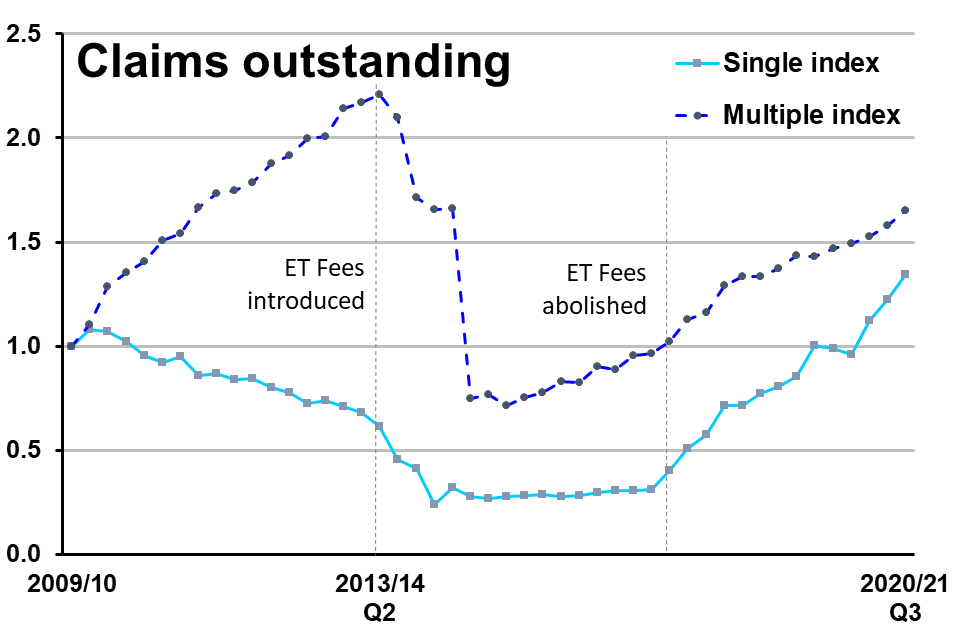
* Baseline 2009/10 Q1
The number of single claim receipts has increased by 25% to 13,200 in the current quarter, when compared to the same period in 2019, most likely due to the rise in unemployment and changes to working conditions seen during the COVID-19 pandemic. Caseload outstanding (at 44,000) continues to rise having passed the peak levels seen in 2009/10 (when it was 36,000 in Q2 of that year) in the first quarter of the 2020/21 financial year, driven by the increase seen in single claim receipts and disposals being continuously lower than receipts.
There were 29,000 multiple claims received this quarter, up 82% on the same period last year. Multiple claims tend to be more volatile as they can be skewed by a high number of claims against a single employer. The multiple claims received this quarter related to 1,000 multiple claim cases (averaging 27 claims per multiple case). This is up from 630 multiple cases in the same period a year ago, which had an average of 12 claims per case. This rise in Employment tribunal receipts is likely to continue as the economy has faced a severe shock following the impact of Covid-19 and could be further accelerated when the furlough scheme ends.
A very high number of ET appeal receipts are yet to be vetted, coded and then allocated a jurisdictional complaint type. This delay has mostly been caused by backlogs due to COVID restriction. These complaints have been put in the “Others” category and will be reallocated and figures revised in the next publication.
The Employment Tribunal disposed of 14,000 claims during October to December 2020, up 24% on the same period in 2019. This was due to a 66% increase in multiple claim disposals (to 6,700). The multiple claims disposed of relate to 560 multiple cases, up from 510 cases in October to December 2019.
In October to December 2020, 27% of disposals were ACAS[footnote 2] conciliated settlements (the most common outcome this quarter), 22% were dismissed upon withdrawal, 20% were withdrawn, 9% were struck out (not at a hearing) and 7% were successful at hearing. The most common jurisdictional complaint disposed of between October to December 2020 was ‘Working time’, whereas ‘Unfair dismissal’ was the most common complaint in October to December 2019.
The high disposal time for equal pay single claims is the result of a large number of claims that were settled and withdrawn earlier but the Judgement was only signed in the October to December 2020/21 financial quarter.
Employment Tribunal Fee (ET) Refunds
From the launch of the ET fee refund scheme in October 2017 to 31 December 2020, there were 22,000 applications for refunds received and 23,000 refund payments made, with a total monetary value of £18.5 million.
Between 1 October 2020 and 31 December 2020, 22 refund applications were received (down from 39 in Q2 2020/21) and 48 refund payments[footnote 3] were made with a total value of £166,000.
The ET fee refund scheme[footnote 4] was introduced as a phased implementation scheme in October 2017 following the abolition of ET fees on 26 July 2017. Since the introduction of the scheme, a total of 22,000 applications for refunds have been received and 23,000 payments have been made, with a total value of £18,501,000 as at 31 December 2020.
The cumulative number of payments is higher than the number of applications because the applications figure is still provisional. Online applications that are processed without manual input are not included in these figures. The number of applications will be updated in a later publication.
Of the applications received between October to December 2020, 95% (21 applications) related to cases initially brought in England and Wales, up from 54% in the quarter to 30 September 2020. The remaining 5% of applications received this quarter (one application) related to cases initially brought in Scotland.
In the quarter October to December 2020, 48 refund payments were made by the MoJ, with a total monetary value of £166,000. Of these:
-
92% (44 refunds) related to England and Wales, 8% (four refunds) to Scotland.
-
85% (41 refunds) related to single claims, 13% (six refunds) related to multiple claims. As each refund payment may relate to several fees paid by the claimant for several cases, 2% (one refund) relate to both single and multiple claims.
Figure 4.4: Employment Tribunal fees – refund applications received, Q3 2017/18 – Q3 2020/21 (Source: Tables ETFR_1)
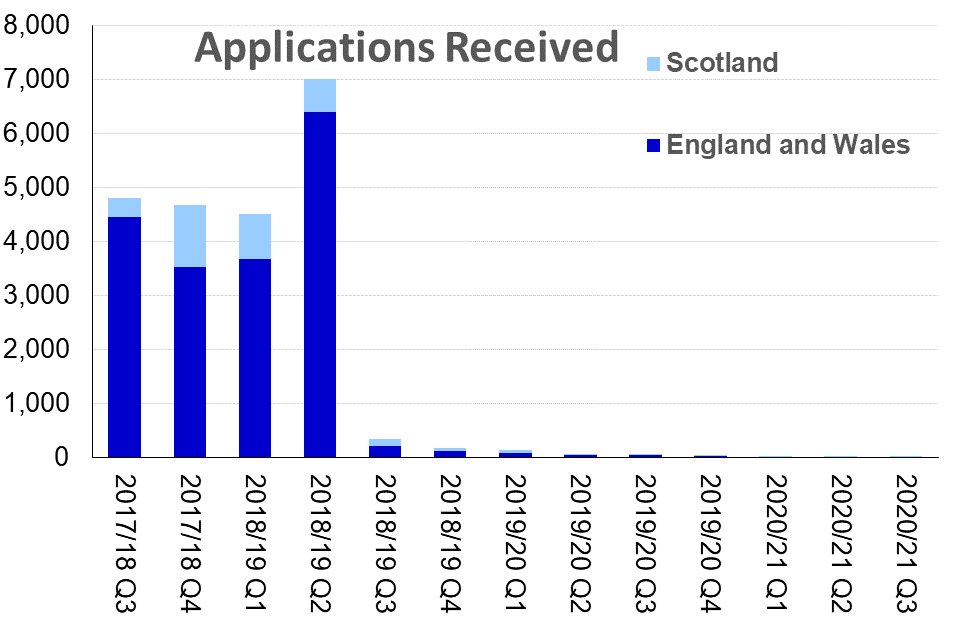
Figure 4.5: Employment Tribunal fees – refund applications processed, Q3 2017/18 – Q3 2020/21 (Source: Tables ETFR_1)

Figure 4.6: Employment Tribunal fees – refund payments made, Q3 2017/18 – Q3 2020/21 (Source: Tables ETFR_2)
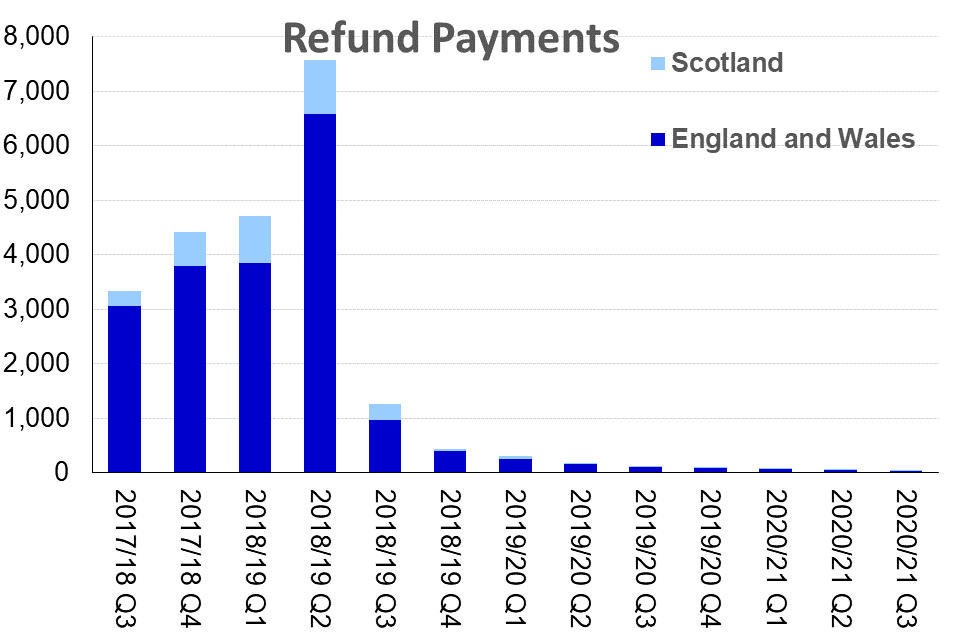
The large drop seen between Q2 and Q3 2018/19 follows the mailshot campaign which ended in July 2018 and resulted in exceptionally high receipts initially, particularly in England and Wales.
Due to the low volumes of ET fee refund applications and payments, these figures will be reported annually after this financial year.
5. Gender Recognition Certificates
110 Gender Recognition Panel (GRP) applications were received and 150 were disposed of between October to December 2020; 190 applications were pending by the end of December 2020
One more application was received by the GRP this quarter, compared to October to December 2019. Of the 150 applications disposed of, a full Gender Recognition Certificate (GRC) was granted in 93% of cases (140 full GRCs), less than one percentage point higher than in the same period in 2019 (where 110 full GRCs were granted out of 120 disposals).
Since April 2005/06, when the Gender Recognition Act 2004 came into effect, 72% of interim certificates (170 of the 230 interim GRCs granted) have been converted to a full GRC, 53% of which were converted within 30 weeks. One interim certificate was converted to a full GRC between October to December 2020.
Of the 140 full certificates granted in October to December 2020, seven were for married applicants and 133 for single applicants. 85 (61%) of the individuals granted full certificates were registered male at birth while 55 (39%) were registered female at birth.
Figure 5.1: Applications for Gender Recognition Certificates received, disposed of and pending, 2009/10 to 2019/20 (Source: Tables GRP_1 and GRP_2)

Figure 5.2: Full Gender Recognition Certificates granted by year of birth, 2009/10 to 2019/20 (Source: Table GRP_4)
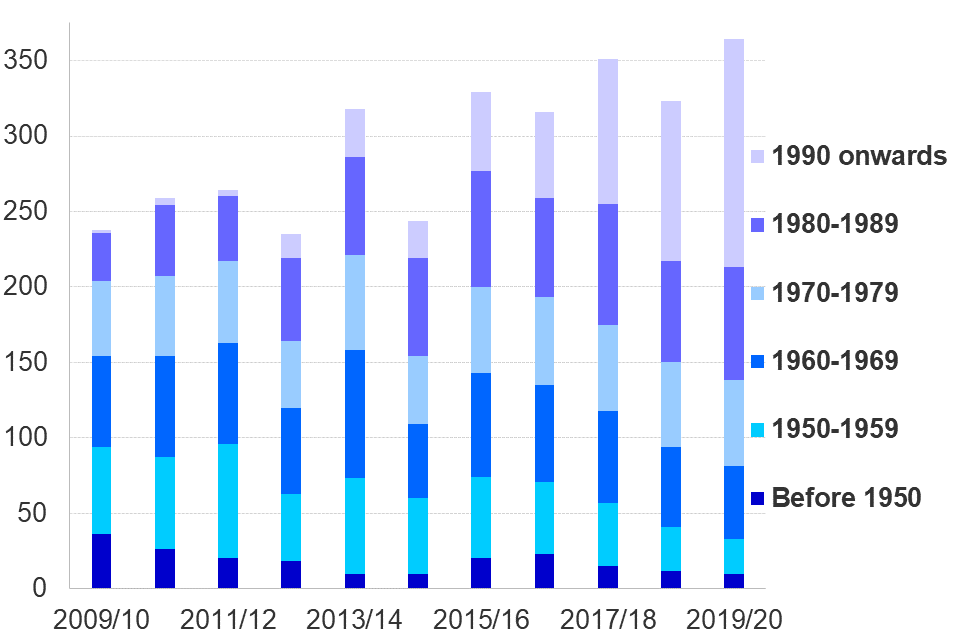
6. Further information
Rounding convention
Figures greater than 10,000 are rounded to the nearest 1,000, those between 1,000 and 10,000 are rounded to the nearest 100 and those between 100 to 1,000 are rounded to the nearest 10. Less than 100 are given as the actual number.
Accompanying files
As well as this bulletin, the following products are published as part of this release:
-
A supporting document providing further information on how the data is collected and processed, as well as information on the revisions policy and legislation relevant to trends and background on the functioning of the tribunal system.
-
The quality statement published with this guide sets out our policies for producing quality statistical outputs for the information we provide to maintain our users’ understanding and trust.
-
A set of overview tables, covering each section of this bulletin and two additional sets of tables on Employment Tribunals (for ET Fee Refunds and ET Management information – Annex C).
-
A set of CSV files including data on two of the three large tribunals (Employment and Immigration and Asylum) and an overall receipts and disposals CSV, covering all tribunal types.
-
Additional releases this quarter:
- Update to the statistical notice on Immigration and Asylum (I&A) Detained Immigration Appeals (DIA) to include data to Q3 2020/21.
Future publications
Our statisticians regularly review the content of publications. Development of new and improved statistical outputs is usually dependent on reallocating existing resources. As part of our continual review and prioritisation, we welcome user feedback on existing outputs including content, breadth, frequency and methodology. Please send any comments you have on this publication including suggestions for further developments or reductions in content.
Contact
Press enquiries should be directed to the Ministry of Justice or HMCTS press office:
Daniel Mulloy - email: Daniel.Mulloy@Justice.gov.uk
Other enquiries and feedback on these statistics should be directed to the Justice Statistics Analytical Services division of the Ministry of Justice:
Carly Gray - email: CAJS@justice.gov.uk
Next update: 10 June 2021 (URL: www.gov.uk/government/collections/tribunals-statistics)
© Crown copyright Produced by the Ministry of Justice
For any feedback on the layout or content of this publication or requests for alternative formats, please contact CAJS@justice.gov.uk
-
The Q3 2014/15 disposals data point is not included for disposals, in order to aid comparability. This figure was a disproportionately high outlier (index: 24.2) due to the disposal of a large multiple claim against an airline. ↩
-
Advisory, Conciliation and Arbitration Service (ACAS) ↩
-
Note that refund payments may relate to applications made in previous quarters. ↩
-
More information on the scheme is available here https://www.gov.uk/government/news/opening-stage-of-employment-tribunal-fee-refund-scheme-launched ↩
